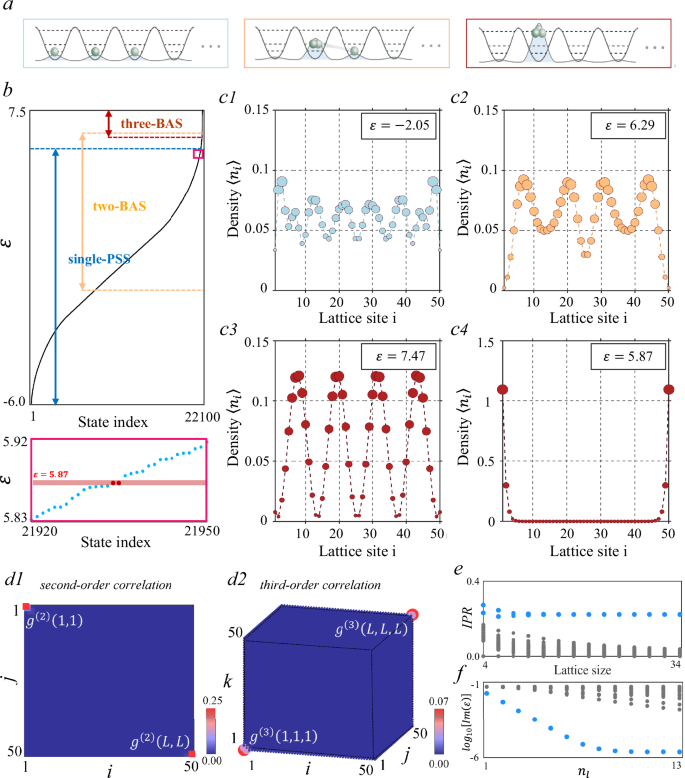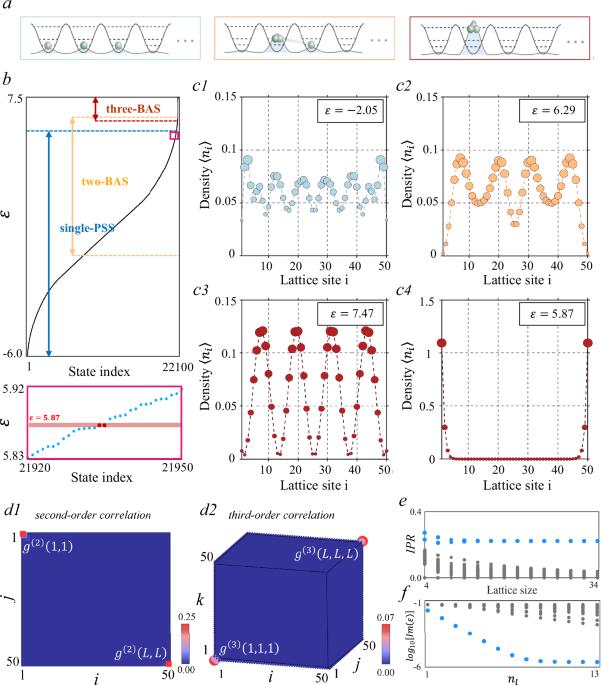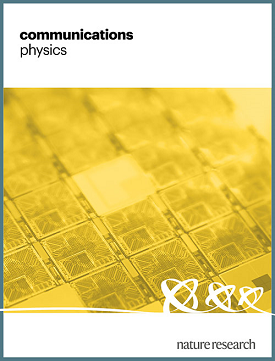Boundary-localized many-body bound states in the continuum
IF 5.4
1区 物理与天体物理
Q1 PHYSICS, MULTIDISCIPLINARY
引用次数: 0
Abstract
Bound states in the continuum (BICs), referring to spatially localized bound states with energies falling within the range of extended modes, have been extensively investigated in single-particle systems, leading to diverse applications in photonics, acoustics, and other classical-wave systems. Recently, there has been theoretical interest in exploring many-body BICs in interacting quantum systems, which necessitate the careful design of impurity potentials or spatial profiles of interaction. Here, we propose a type of many-body BICs localized at boundaries, which can be purely induced by the uniform onsite interaction without requiring any specific design of impurity potential or nonlocal interaction. We numerically show that three or more interacting bosons can concentrate on the boundary of a homogeneous one-dimensional lattice, which is absent at single- and two-particle counterparts. Moreover, the eigenenergy of multi-boson bound states can embed within the continuous energy spectra of extended scattering states, thereby giving rise to interaction-induced boundary many-body BICs. Furthermore, by mapping Fock states of three and four bosons to nonlinear circuit networks, we experimentally simulate boundary many-body BICs. Our findings enrich the comprehension of correlated BICs beyond the single-particle level, and have the potential to inspire future investigations on exploring many-body BICs. Bound states in the continuum (BICs) have been extensively investigated in single-particle systems, leading to diverse applications in photonics, acoustics, and other classical-wave systems. Here, the authors propose a type of interaction-induced many-body BICs at boundaries and experimentally simulate these boundary many-body BICs using nonlinear circuit networks.


连续体中的边界局部多体束缚态
连续体中的束缚态(BIC)是指能量在扩展模式范围内的空间局部束缚态,在单粒子系统中已被广泛研究,并在光子学、声学和其他经典波系统中得到了多种应用。最近,理论界对探索相互作用量子系统中的多体 BIC 产生了浓厚的兴趣,这就需要精心设计杂质势或相互作用的空间轮廓。在这里,我们提出了一种在边界局部的多体 BIC,它可以纯粹由均匀的场内相互作用诱发,而不需要任何特定的杂质势或非局域相互作用设计。我们用数值方法证明,三个或更多相互作用玻色子可以集中在均质一维晶格的边界上,而这在单粒子和双粒子对应物上是不存在的。此外,多玻色子束缚态的特征能可以嵌入扩展散射态的连续能谱中,从而产生相互作用诱导的边界多体 BIC。此外,通过将三玻色子和四玻色子的 Fock 状态映射到非线性电路网络,我们在实验中模拟了边界多体 BIC。我们的发现丰富了对单粒子层面之外的相关BIC的理解,并有可能启发未来探索多体BIC的研究。连续体中的边界态(BICs)已在单粒子系统中得到广泛研究,并在光子学、声学和其他经典波系统中得到多种应用。在此,作者提出了一种相互作用诱导的边界多体 BIC,并利用非线性电路网络对这些边界多体 BIC 进行了实验模拟。
本文章由计算机程序翻译,如有差异,请以英文原文为准。
求助全文
约1分钟内获得全文
求助全文
来源期刊

Communications Physics
Physics and Astronomy-General Physics and Astronomy
CiteScore
8.40
自引率
3.60%
发文量
276
审稿时长
13 weeks
期刊介绍:
Communications Physics is an open access journal from Nature Research publishing high-quality research, reviews and commentary in all areas of the physical sciences. Research papers published by the journal represent significant advances bringing new insight to a specialized area of research in physics. We also aim to provide a community forum for issues of importance to all physicists, regardless of sub-discipline.
The scope of the journal covers all areas of experimental, applied, fundamental, and interdisciplinary physical sciences. Primary research published in Communications Physics includes novel experimental results, new techniques or computational methods that may influence the work of others in the sub-discipline. We also consider submissions from adjacent research fields where the central advance of the study is of interest to physicists, for example material sciences, physical chemistry and technologies.
 求助内容:
求助内容: 应助结果提醒方式:
应助结果提醒方式:


